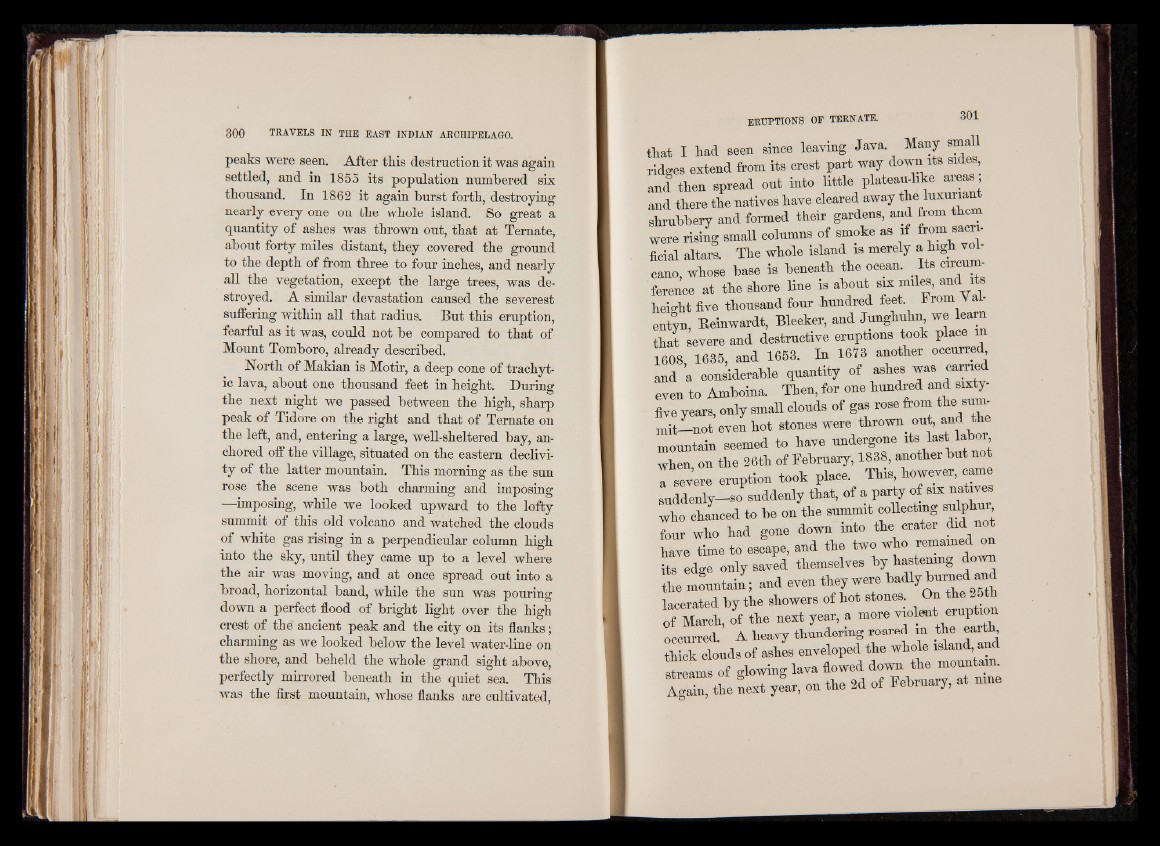
peaks were seen. After this destruction it was again
settled, and in 1855 its population numbered six
thousand. In 1862 it again burst forth, destroying
nearly every one on the whole island. So great a
quantity of ashes was thrown out, that at Ternate,
about forty miles distant, they covered the ground
to the depth of from three to four inches, and nearly
all the vegetation, except the large trees, was de-
stroyed. A similar devastation caused the severest
suffering within all that radius. But this eruption,
fearful as it was, could not be compared to that of
Mount Tomboro, already described.
North of Makian is Motir, a deep cone of trachyt-
ic lava, about one thousand feet in height. During
the next night we passed between the high, sharp
peak of Tidore on the right and that of Ternate on
the left, and, entering a large, well-sheltered bay, anchored
off the village, situated on the eastern declivity
of the latter mountain. This morning as the sun
rose the scene was both charming and imposing
—imposing, while we looked upward to the lofty
summit of this old volcano and watched the clouds
of white gas rising in a perpendicular column high
into the sky, until they came up to a level where
the air was moving, and at once spread out into a
broad, horizontal band, while the sun was pouring
down a perfect flood of bright light over the high
crest of the ancient peak and the city on its flanks;
charming as we looked below the level water-line on
the shore, and beheld the whole grand sight above,
perfectly mirrored beneath in the quiet sea. This
was the first mountain, whose flanks are cultivated,
that I had seen since leaving Java. Many sma
ridges extend from its crest part way down its sides,
and then spread out into little plateau-like areas,
and there the natives have cleared away fclu> lux.iw
shrubbery and formed their gardens, and from them
were rising small columns of smoke as if from sacrificial
altars. The whole island is merely a high volcano,
whose base is beneath the ocean. Egg circumference
at the shore line is about six miles, and its
height five thousand four hundred feet From Yal-
entyn, Reinwardt, Bleeker, and Junghuhn, we learn
that severe and destructive eruptions took place in
1608 1635, and 1653. In 1673 another occurred
and a considerable quantity of ashes was earned
even to Amboina. Then, for one hundred and sixty-
five years, only small clouds of gas rose from the sum-
mit—-not even hot stones were thrown out and the
mountain seemed to have undergone
when on the 26th of February, 1838, another but no
I severe eruption took place. This, however, came
suddenly—so suddenly that, of a party of six natives
who chanced to be on the summit collecting sulphur,
four who had gone down into the crater did
have time to escape, and the two who remained on
its edge only saved themselves by hastening down
the mountain; and even they were
lacerated by the showers of hot stones. On the 25th
of March, of the next year, a more
occurred. A heavy thundering roared m the earth
thick clouds of ashes enveloped the whole island, am
streams of glowing lava flowed down the mountain,
“ the next yem, on the 2d of February, at nine